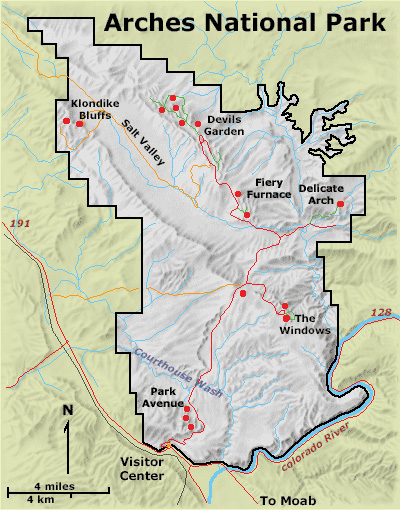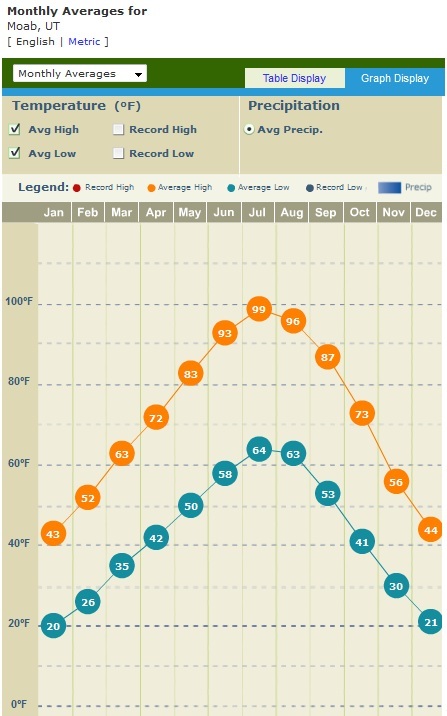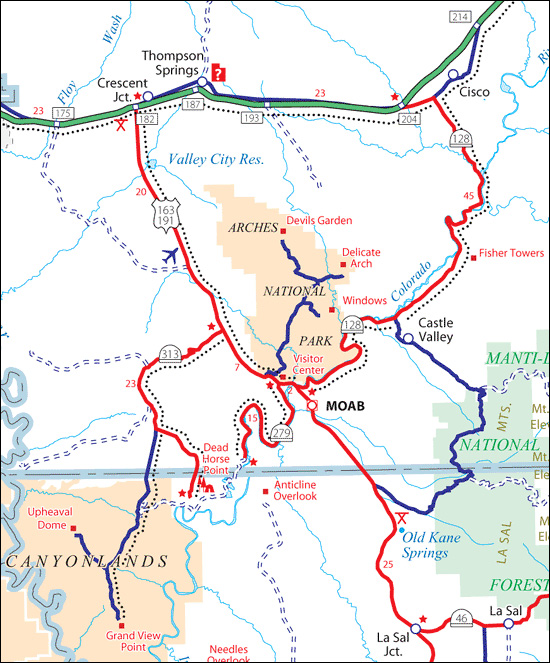Arches National Park is an iconic destination for both tourists and photographers. It is one of the more spectacular locations in North America with a wealth of photographic possibilities in Arches and other nearby parks.
Double Arch, one of the classic photos in the park, is located a short walk north from “The Windows” area parking lot (the upper of the two red dots in The Windows area of the map below). North Window, South Window, and Turret Arch are all a short walk (15 minutes or less) from the same parking lot (the lower of the two red dots in The Windows area).
This photo was taken in mid-morning. Early to mid-morning is a good time of day to photograph Double Arch. I used a 17-40mm lens at a focal length of 21 mm to frame the arches. If you get in close to the arches to shoot up (which I recommend), you will need a very wide angle lens to take it all in, about 20 mm with a full frame sensor and about 12-13 mm with a cropped frame sensor (with a 1.5x or 1.6x field of view crop). If you stand right under the arches, you will need a 180 degree fisheye lens to get it all in. I used a polarizing filter to darken the blue sky in relationship to the arches. It also gave me better color on the sandstone surfaces by cutting glare. The exposure was f/11, 1/30 second at ISO 100. I based my exposure on the sunlit areas of sandstone. The sunlit sandstone acted like a reflector and bounced light up into the shaded areas of the arches.
There are dozens of good locations relatively close to the roads to do photography in the park, and countless locations if you are willing to do some serious hiking. Depending on the particular arch and where you are standing, some arches (like Double Arch) photograph best in the morning while others look best in the afternoon and evening. The guide book suggested below will give you specific suggestions for different locations. Given the right conditions, warm sunlight casts long shadows across the land at sunrise and sunset, creating excellent photo opportunities.
You can go to Arches any time of year, but I prefer spring and fall when day time highs are more tolerable. There will also be less tourists. Highs are in the 70s in April and October, the 80s in May and September, and in the 90s in June, July and August. Do not wander far from your car in the summer without taking plenty of water with you. Take seriously the warnings about the heat. Take a jacket too. This is high dessert country and it can get chilly at night, even in the summer.
Moab, Utah is the place to stay. Moab is popular year around so book ahead. If you are looking for a place to stay at the last minute, expect to pay some high prices. The more economical lodging books up early. Prices for lodging can also rise dramatically as you go from early spring to summer (another reason to go in early spring) of for special events. Moab is a mecca for outdoorsy types who hike, bike, and take their 4 wheel drive vehicles into impossible places. Add in photographers and other tourists and it can be a very busy place.
The entrance to Arches N.P. is just a couple of miles north of Moab. Dead Horse Point State Park and Canyonlands National Park are both within 45 miles of Moab.
UT State Route 128 heading northeast of Moab is a State and National Scenic Byway and will take you to Castle Valley (reminiscent of Monument Valley) and Fisher Towers. It follows the Colorado River for the stretch just outside of Moab.
You could easily spend several days to a week in the Moab area (and many people do). With so many great locations, a huge photographic challenge is where to spend sunrise and sunset each day. Too bad photographers only get one sunrise and one sunset each day (at the most).
Books
Two books will be very helpful if you want to do some serious photography in the Arches/Moab area.
Digital Photography Exposure for Dummies (rated 5 stars at Amazon.com) will teach you what you need to know to get the best possible exposures (and the best possible images) in the high contrast lighting situations you will encounter in the high dessert. It will also show you how to “read the light” to find the best light, get the best possible images, and make the most of the existing lighting conditions. The chapters on landscape photography, flowers (depending on the time of year), and low light photography will also be very helpful. You can learn more here and buy it here.
The best photographic guide book for the Moab area (and the rest of Southern Utah) is Photographing the Southwest, Volume 1 – A Guide to the natural landmarks of Southern Utah by Laurent Martres. This book is part of a terrific three book set. All guide books for photographers should be as well done as these books are! Beautifully illustrated, they cover the best scenic locations, show you how to get there, and tell you the best time to be there (season of the year and time of day). In the back of each book is a table of ratings. Each location is rated for Scenic Value, Photographic Interest, Road Difficulty, and Trail Difficulty (if you have to walk/hike to the location). If you have limited time in an area, you can tell at a glance which locations in an area are the most impressive, on good roads, and no more than a short walk from the road. You can learn more and buy the book here at my photographer store (which is powered by Amazon.com with Amazon’s great prices, ordering and delivery system).
Links
You can order a print of the above photo in the Utah gallery at JimDoty.Zenfolio.com.
Scenic Guides for Photographers
The Best “How To” Landscapes and Nature Photography Books




